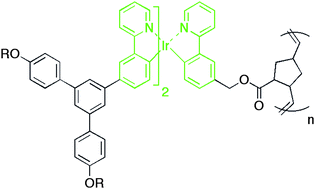The development of poly(dendrimer)s for advanced processing
Abstract
A

* Corresponding authors
a Department of Chemistry, University of Oxford, Chemistry Research Laboratory, Mansfield Rd, Oxford, UK
b
Organic Semiconductor Centre, SUPA, School of Physics and Astronomy, University of St. Andrews, North Haugh, St. Andrews, Fife, UK
E-mail:
idws@st-andrews.ac.uk
c EPSRC National Mass Spectrometry Service Centre (NMSSC), Institute of Mass Spectrometry (IMS), School of Medicine, Swansea University, Singleton Park, Swansea, UK
d
Centre for Organic Photonics & Electronics, School of Molecular and Microbial Sciences, University of Queensland, Chemistry Building, Queensland, Australia
E-mail:
p.burn2@uq.edu.au
A

 Please wait while we load your content...
Something went wrong. Try again?
Please wait while we load your content...
Something went wrong. Try again?
J. P. Gunning, J. W. Levell, M. F. Wyatt, P. L. Burn, J. Robertson and I. D. W. Samuel, Polym. Chem., 2010, 1, 730 DOI: 10.1039/C0PY00039F
To request permission to reproduce material from this article, please go to the Copyright Clearance Center request page.
If you are an author contributing to an RSC publication, you do not need to request permission provided correct acknowledgement is given.
If you are the author of this article, you do not need to request permission to reproduce figures and diagrams provided correct acknowledgement is given. If you want to reproduce the whole article in a third-party publication (excluding your thesis/dissertation for which permission is not required) please go to the Copyright Clearance Center request page.
Read more about how to correctly acknowledge RSC content.
 Fetching data from CrossRef.
Fetching data from CrossRef.
This may take some time to load.
Loading related content
